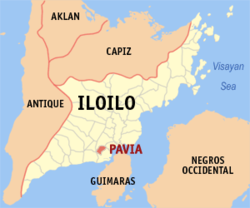Pavia, Iloilo
| Pavia | ||
|---|---|---|
| Municipality | ||
| Municipality of Pavia | ||
|
||
 Map of Iloilo showing the location of Pavia |
||
| Location within the Philippines | ||
| Coordinates: 10°46′30″N 122°32′30″E / 10.775°N 122.5417°ECoordinates: 10°46′30″N 122°32′30″E / 10.775°N 122.5417°E | ||
| Country |
|
|
| Region | Western Visayas (Region VI) | |
| Province | Iloilo | |
| Legislative district | 2nd district of Iloilo | |
| Founded | 1848 | |
| Barangays | 18 | |
| Government | ||
| • Mayor | Michael B. Gorriceta | |
| • Vice Mayor | Michael Gumban | |
| • Congressman | Arcadio H. Gorriceta | |
| Area | ||
| • Total | 27.15 km2 (10.48 sq mi) | |
| Population (2015 census) | ||
| • Total | 55,603 | |
| • Density | 2,000/km2 (5,300/sq mi) | |
| Demonym(s) | Pavianhon | |
| Time zone | PST (UTC+8) | |
| ZIP code | 5001 | |
| IDD : area code | +63 (0)33 | |
| Website | www |
|
Pavia is a second-class municipality in the province of Iloilo, Philippines. According to the 2015 census, it has a population of 55,603 people.
Pavia is the smallest municipality in terms of area in Iloilo, covering only 2,715 hectares (6,710 acres). The municipality is the Regional Agro-Industrial Center for Western Visayas and is located 10 kilometres (6.2 mi) north of Iloilo City.
The Catholic church, currently undergoing restoration, is similar to one in Pavia, Italy.
How the town got its name is unclear, and has long been disputed. One theory has it that the name came from a certain Colonel Pavia of the Spanish garrison in Iloilo who was supposedly responsible for initially establishing a Spanish presence in the area. Others believe that the name is a Spanish corruption of the Hiligaynon word biya-biya, as the area was originally considered a neglected patch of land that served mostly as a camping ground for city sophisticates and absentee landlords. Others claim that the town was named after a Spanish governor-general, Manuel Pavia y Lay, Marquis of Novaliches, who eventually became a priest after his short tenure in the Philippines from 1853-1854. However, the more credible theory seems to be the overlooked fact that the town's religious well-being was placed under the jurisdiction and supervision of the friars of the Augustinian Order, and they simply named the place in honor of the town of Pavia, Italy, where the founder of their order, Saint Augustine, was buried.
The last theory seems to be supported by circumstantial historical evidence: it was also in 1862 that an independent parish dedicated to Saint Monica was established by an Augustinian friar, Policarpio Minayo. But it was only in 1889 when construction of the famous brick church—as it now stands—began. It was envisioned and built in the Byzantine style, with Romanesque design elements. Two Greek crosses dominate the facade, and the transept is round set against the rear wall. It is unique in the whole of Panay Island, as it is the only church built entirely of red brick, inside and out. Quite significantly, the church design was apparently inspired by the ancient royal arched basilica of San Michele Maggiore in Pavia, Italy—minus the front columns.
...
Wikipedia


